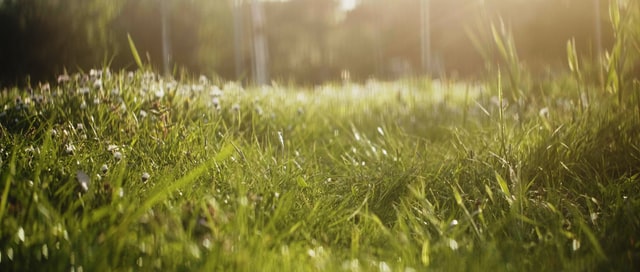
Summer is here and that means it’s time to start enjoying your lawn. As the temperatures rise, we are reminded that this is the season to spend time outside. And the foundation for enjoying your outdoors is a beautiful lawn! To ensure a beautiful lawn all summer long, read on for these 5 tips fr summer lawn care.
1. Preparing for Summer Lawn Care
When making a summer lawn care plan, it’s best to think of the season in phases: Early, mid, and late summer. How you care for your lawn varies according to the phase. Each phase includes the basics of fertilizing, watering, and mowing.
However, in the early summer, you will also treat your lawn for summer pests and weeds. You or your lawn care company should apply weed control only as needed. This will ensure you kill the weeds without harming the surrounding grass. Additionally, you will need to be on the lookout for pests seen in the summer months. Proper identification of lawn pests such as grubs and turf caterpillars is important to protect your lawn. Keep an eye out for feeding symptoms throughout the summer. If you see unusually high feeding activity or if your lawn begins to wilt in patches or form bare patches, it could be signs of an insect infestation.
2. Fertilizing Your Summer Lawn
Feeding your lawn is an important part of summer lawn care. You should apply a slow-release fertilizer to your lawn once every 6 to 8 weeks. Applying fertilizer to your grass can help to keep your lawn healthy, especially in the face of possible issues like pests or drought. Choose a slow-release lawn fertilizer and follow the manufacturer’s instructions for how to apply it. Preferably, look for a granular fertilizer that you can just sprinkle onto the lawn.
Fertilizing in the early summer is best for warm-season grass, like Bermuda and Zoysia. These are the most common in the Southeast. These grasses grow best at about 70 degrees Fahrenheit. Fertilizer will give them the boost to grow thick and healthy.
However, if you apply too much fertilizer, you run the risk of burning your lawn. Grass already gets stressed during the hottest months, so maintain caution when applying it.
3. How to Water Your Lawn in the Summer
Dry, hot weather can deplete your soil moisture. To combat this, you should water thoroughly about once or twice a week. But double-check that your region isn’t experiencing any drought conditions that call for water restrictions. In that case, you may need to cut back on water and allow your lawn to go dormant.
But in normal summer conditions, the goal is to water deeply and infrequently. The water should reach 4–6 inches deep. If you’re unsure if your water is reaching deep into the soil, try a simple test. Just push a screwdriver into your soil and see how far it goes. If you get a lot of resistance, you need to water more. If it slides in too easily, you need to water your lawn less.
In the summer, it’s best to water your lawn in the early morning, preferably before sunrise. That’ll keep the sun from drying out the moisture before your lawn can soak it up. You should also take care not to water right after rain. Check with your local water authority or Cooperative Extension System office for recommended irrigation schedules in your area.
4. The Best Way to Mow your Summer Lawn
In the summer, mow the grass high to encourage strong root growth and heat tolerance. Taller grass provides more shade, keeping weeds from germinating and competing with your turf. When the grass blades are left taller, they keep the surface of the soil from drying out, reducing the need for watering.
When mowing your lawn in the summer, be sure to use sharp blades. Dull blades will tear and shred your grass, defeating your summer lawn care efforts.
Set your blades higher in the summer months, and cut the heights according to grass type. Warm-season grasses, such as those found in the Southeast, should be cut to 2–3 inches tall. As a general rule, try not to cut more than ⅓ of the grass blade each time you mow. That may mean more frequent trims at a higher blade setting.
Additionally, when you mow, be sure to grasscycle, or leave the clippings on the lawn. They will decompose and help feed your grass.
5. Summer Lawn Care Problems
To keep your summer lawn in top shape, you’ll need to be vigilant. Many different issues can impact your lawn, so best to prepare for them in advance.
Look for signs of insects, pests, and diseases in the lawn. If issues crop up, you’ll need to address them quickly.
Bald spots in your lawn make it more vulnerable to summer heat. To prevent bald spots from occurring, mow your lawn at or close to the highest setting on your mower. Be careful to avoid stepping on your lawn when it is wet.
Pets can cause damage to your lawn, so clean up after them right away and flush away urine spots.
Avoid parking on the grass. Driving or parking on the lawn is never a good idea. It leads to soil compaction, which can cause a host of other problems, including dead grass. During drought or excessive heat, it’s even wise to limit foot traffic on your lawn to avoid damaging turf crowns.
Pick up litter.
Summer activities can result in toys, water games, lawn chairs, or tools being left on turf. Take the time to pick up everything to avoid damaging the lawn.
Tackle weeds by applying weed control, following label instructions. If you act fast in the summer, you can kill established weeds before they bloom and spread seeds. But be aware that herbicides may hurt your grass, so use them sparingly. Alternatively, you can avoid chemical weed control with attentive summer lawn care. Walk your lawn on an every other day basis to find any instance of weeds and remove them as soon as possible. This will allow you to catch newly formed weeds before they have a chance to grow roots.
Summer Lawn Care For Green Grass All Season
Summer heat can take a toll on turf, especially if you leave it up to chance. If you mow too low, water too much or too little, or ignore early signs of pests, your grass will suffer. It might even completely die in small or large patches! Keep your lawn looking its best all summer long by mastering these summer care tips. And if you’re ready to install high-quality turf to get your lawn started, reach out to the pros at The TurfGrass Group today!
